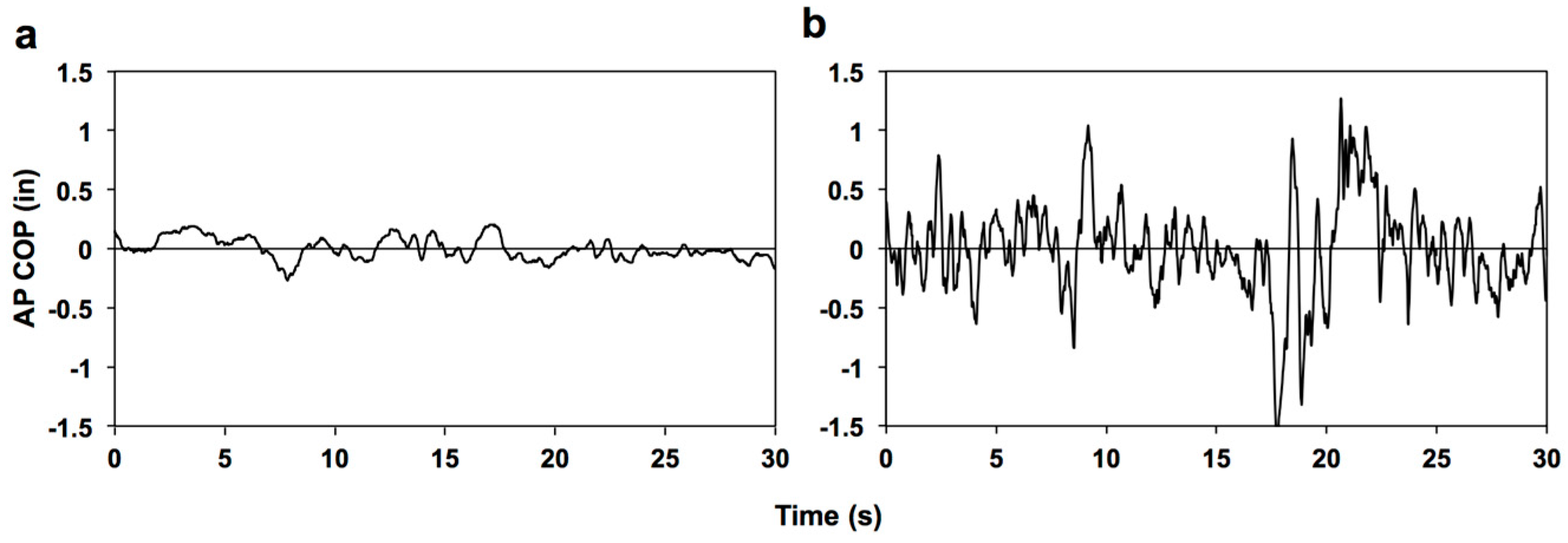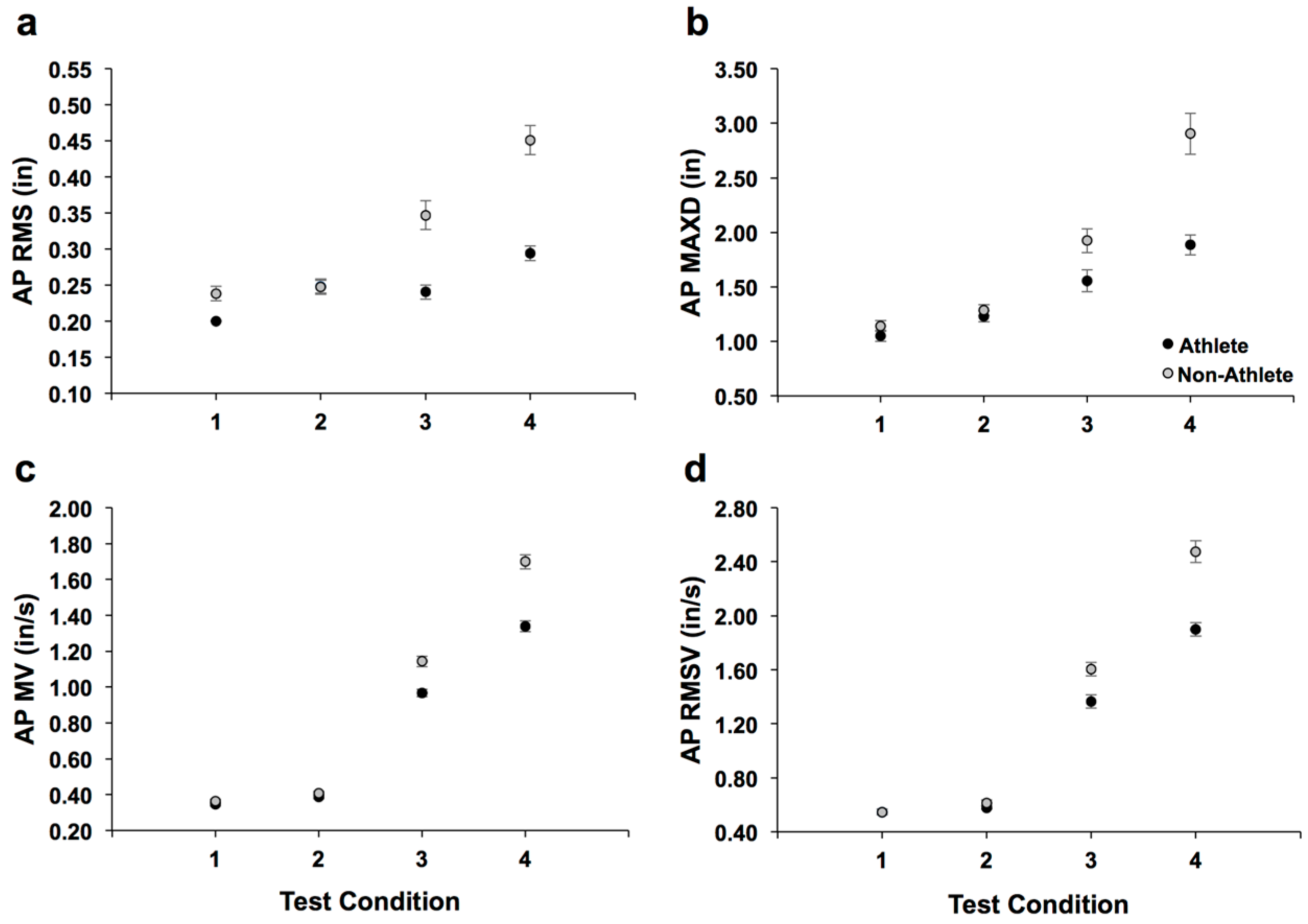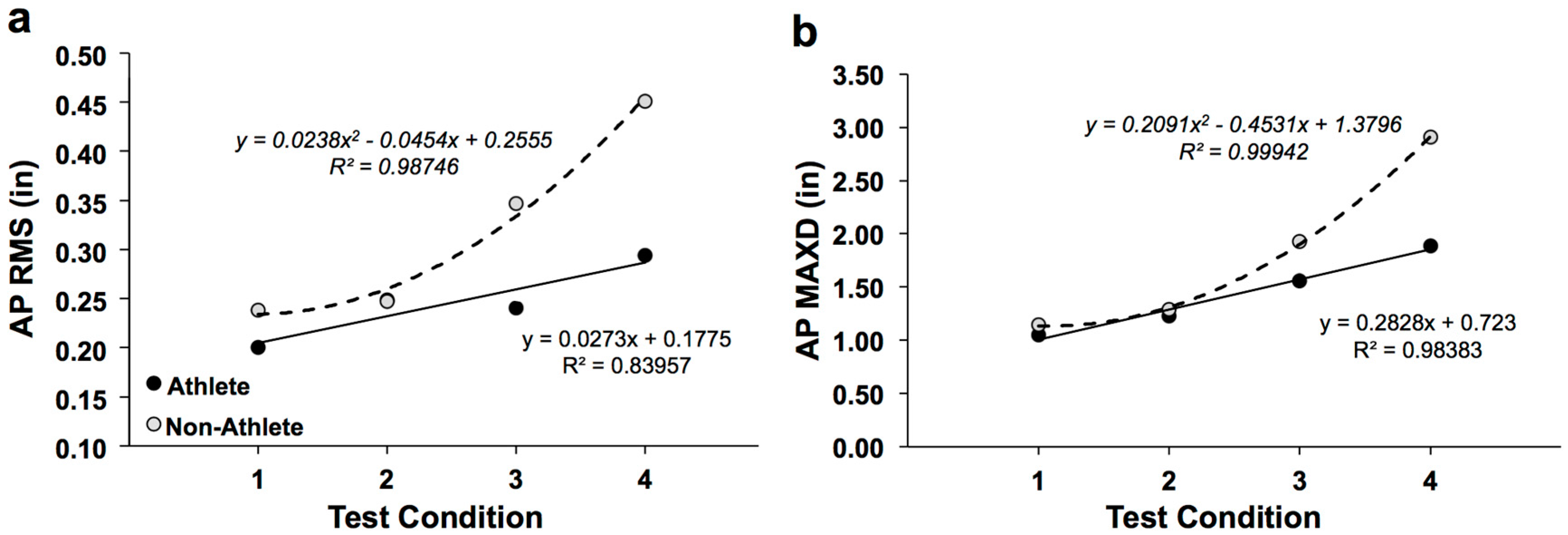Balance Performance as Observed by Center-of-Pressure Parameter Characteristics in Male Soccer Athletes and Non-Athletes
Abstract
:1. Introduction
2. Materials and Methods
2.1. Participants
2.2. Protocol
2.3. Equipment and Data Analysis
3. Results
3.1. AP and ML COP Displacement and Velocity Parameters as a Function of Quiet Stance Test Condition
3.2. AP Displacement and Velocity Parameter Characteristics
4. Discussion
5. Conclusions
Acknowledgments
Author Contributions
Conflicts of Interest
Appendix A
References
- Horak, F.B.; Macpherson, J.M. Postural Orientation and Equilibrium. In Comprehensive Physiology; R.S. Dow Neurological Sciences Institute Legacy Good Samaritan Hospital & Medical Center: Portland, OR, USA, 1996; pp. 255–292. [Google Scholar]
- Winter, D.A. Human balance and posture control during standing and walking. Gait Posture 1995, 3, 193–214. [Google Scholar] [CrossRef]
- Yazicioglu, K.; Taskaynatan, M.A.; Guzelkucuk, U.; Tugcu, I. Effects of playing football (soccer) on balance, strength, and quality of life in unilateral below-knee amputees. Am. J. Phys. Med. Rehabil. 2007, 86, 800–805. [Google Scholar] [CrossRef] [PubMed]
- Blum, L.; Korner-Bitensky, N. Usefulness of the Berg Balance Scale in stroke rehabilitation: A systematic review. Phys. Ther. 2008, 88, 559–566. [Google Scholar] [CrossRef] [PubMed]
- Berg, K.; Wood-Dauphinee, S.; Williams, J.I. The Balance Scale: Reliability assessment with elderly residents and patients with an acute stroke. Scand. J. Rehabil. Med. 1995, 27, 27–36. [Google Scholar] [PubMed]
- Plisky, P.J.; Rauh, M.J.; Kaminski, T.W.; Underwood, F.B. Star Excursion Balance Test as a predictor of lower extremity injury in high school basketball players. J. Orthop. Sports Phys. Ther. 2006, 36, 911–919. [Google Scholar] [CrossRef] [PubMed]
- Gribble, P.A.; Hertel, J.; Plisky, P. Using the star excursion balance test to assess dynamic postural-control deficits and outcomes in lower extremity injury: A literature and systematic review. J. Athl. Train. 2012, 47, 339–357. [Google Scholar] [CrossRef] [PubMed]
- Bressel, E.; Yonker, J.C.; Kras, J.; Heath, E.M. Comparison of static and dynamic balance in female collegiate soccer, basketball, and gymnastics athletes. J. Athl. Train. 2007, 42, 42–46. [Google Scholar] [PubMed]
- Bell, D.R.; Guskiewicz, K.M.; Clark, M.A.; Padua, D. A systematic review of the balance error scoring system. Sports Health 2011, 3, 287–295. [Google Scholar] [CrossRef] [PubMed]
- Gioftsidou, A.; Malliou, P.; Pafis, G.; Beneka, A.; Tsapralis, K.; Sofokleous, P.; Kouli, O.; Rokka, S.; Godolias, G. Balance training programs for soccer injuries prevention. J. Hum. Sport Exerc. 2012, 7, 639–647. [Google Scholar] [CrossRef]
- Gioftsidou, A.; Malliou, P.; Pafis, G.; Beneka, A.; Godolias, G.; Maganaris, C.N. The effects of soccer training and timing of balance training on balance ability. Eur. J. Appl. Physiol. 2006, 96, 659–664. [Google Scholar] [CrossRef] [PubMed]
- Thorpe, J.L.; Ebersole, K.T. Unilateral balance performance in female collegiate soccer athletes. J. Strength Cond. Res. 2008, 22, 1429–1433. [Google Scholar] [CrossRef] [PubMed]
- Gstöttner, M.; Neher, A.; Scholtz, A.; Millonig, M.; Lembert, S.; Raschner, C. Balance ability and muscle response of the preferred and nonpreferred leg in soccer Players. Mot. Control 2009, 13, 218–231. [Google Scholar] [CrossRef]
- Matsuda, S.; Demura, S.; Nagasawa, Y. Static One-Legged Balance in soccer players during use of a lifted leg. Percept. Mot. Skills 2010, 111, 167–177. [Google Scholar] [CrossRef] [PubMed]
- Bieć, E.; Kuczyński, M. Postural control in 13-year-old soccer players. Eur. J. Appl. Physiol. 2010, 110, 703–708. [Google Scholar] [CrossRef] [PubMed]
- Jakobsen, M.D.; Sundstrup, E.; Krustrup, P.; Aagaard, P. The effect of recreational soccer training and running on postural balance in untrained men. Eur. J. Appl. Physiol. 2011, 111, 521–530. [Google Scholar] [CrossRef] [PubMed]
- Teixeira, L.A.; de Oliveira, D.L.; Romano, R.G.; Correa, S.C. Leg preference and interlateral asymmetry of balance stability in soccer players. Res. Q. Exerc. Sport 2011, 82, 21–27. [Google Scholar] [CrossRef] [PubMed]
- Ricotti, L.; Rigosa, J.; Niosi, A.; Menciassi, A. Analysis of balance, rapidity, force and reaction times of soccer players at different levels of competition. PLoS ONE 2013, 8, e77264. [Google Scholar] [CrossRef] [PubMed]
- Paillard, T.; Noé, F.; Rivière, T.; Marion, V.; Montoya, R.; Dupui, P. Postural performance and strategy in the unipedal stance of soccer players at different levels of competition. J. Athl. Train. 2006, 41, 172–176. [Google Scholar] [PubMed]
- Gerbino, P.G.; Griffin, E.D.; Zurakowski, D. Comparison of standing balance between female collegiate dancers and soccer players. Gait Posture 2007, 26, 501–507. [Google Scholar] [CrossRef] [PubMed]
- Prieto, T.E.; Myklebust, J.B.; Hoffman, R.G.; Lovett, E.G.; Myklebust, B.M. Measures of postural steadiness: Differences between healthy young and elderly adults. IEEE Trans. Biomed. Eng. 1996, 43, 956–966. [Google Scholar] [CrossRef] [PubMed]
- Masani, K.; Popovic, M.R.; Nakazawa, K.; Kouzaki, M.; Nozaki, D. Importance of body sway velocity information in controlling ankle extensor activities during quiet stance. J. Neurophysiol. 2003, 90, 3774–3782. [Google Scholar] [CrossRef] [PubMed]
- Jeka, J.; Kiemel, T.; Creath, R.; Horak, F.; Peterka, R. Controlling human upright posture: Velocity information is more accurate than position or acceleration. J. Neurophysiol. 2004, 92, 2368–2379. [Google Scholar] [CrossRef] [PubMed]
- Maurer, C.; Peterka, R.J. A New interpretation of spontaneous sway measures based on a simple model of human postural control. J. Neurophysiol. 2005, 93, 189–200. [Google Scholar] [CrossRef] [PubMed]
- Peterka, R.J. Sensorimotor Integration in Human Postural Control. J. Neurophysiol. 2002, 88, 1097–1118. [Google Scholar] [PubMed]
- Schrager, M.A.; Kelly, V.E.; Price, R.; Ferrucci, L.A.; Shumway-Cook, A. The effects of age on medio-lateral stability during normal and narrow base walking. Gait Posture 2008, 28, 466–471. [Google Scholar] [CrossRef] [PubMed]




| Test Condition | Anterior-Posterior (AP) | Mediolateral (ML) | ||||||
|---|---|---|---|---|---|---|---|---|
| 1. Eyes-Open/Wide | 2. Eyes-Closed/Wide | 3. Eyes-Open/Tandem | 4. Eyes-Closed/Tandem | 1. Eyes-Open/Wide | 2. Eyes-Closed/Wide | 3. Eyes-Open/Tandem | 4. Eyes-Closed/Tandem | |
| RMS (in) | A = 0.20, NA = 0.24 df = 86, t = −2.65 | A = 0.25, NA = 0.25 df = 87, t = 0.11 | A = 0.24, NA = 0.35 df = 78, t = −4.78 | A = 0.29, NA = 0.45 df = 69, t = −5.62 | A = 0.13, NA = 0.16 df = 72, t = −3.47 | A = 0.15, NA = 0.16 df = 86, t = −0.31 | A = 0.24, NA = 0.27 df = 89, t = −3.42 | A = 0.39, NA = 0.45 df = 84, t = −4.02 |
| MAXD (in) | A = 1.05, NA = 1.14 df = 94, t = −1.26 | A = 1.23, NA = 1.29 df = 94, t = −0.83 | A = 1.56, NA = 1.92 df = 93, t = −2.41 | A = 1.88, NA = 2.91 df = 68, t = −5.62 | A = 0.77, NA = 0.88 df = 92, t = −1.56 | A = 0.83, NA = 0.98 df = 75, t = −2.05 | A = 1.29, NA = 1.45 df = 88, t = −3.00 | A = 1.94, NA = 2.35 df = 75, t = −4.44 |
| MV (in/s) | A = 0.35, NA = 0.36 df = 91, t = −1.16 | A = 0.39, NA = 0.41 df = 94, t = −1.77 | A = 0.97, NA = 1.14 df = 92, t = −4.85 | A = 1.34, NA = 1.70 df = 77, t = −7.29 | A = 0.32, NA = 0.40 df = 94, t = −5.50 | A = 0.33, NA = 0.42 df = 73, t = −5.68 | A = 0.66, NA = 0.74 df = 91, t = −4.59 | A = 1.22, NA= 1.36 df = 81, t = −4.20 |
| RMSV (in/s) | A = 0.55, NA = 0.55 df = 94, t = −0.56 | A = 0.58, NA = 0.61 df = 88, t = −1.88 | A = 1.37, NA = 1.60 df = 94, t = −3.48 | A = 1.90, NA = 2.47 df = 78, t = −6.32 | A = 0.49, NA = 0.58 df = 94, t = −3.95 | A = 0.50, NA = 0.68 df = 59, t = −6.00 | A = 0.96, NA = 1.05 df = 90, t = −3.32 | A = 1.72, NA = 1.92 df = 75, t = −3.74 |
| Insignificant difference | p < 0.05 | p < 0.02 | p < 0.01 | p < 0.005 | p < 0.002 | p < 0.001 |
© 2017 by the authors. Licensee MDPI, Basel, Switzerland. This article is an open access article distributed under the terms and conditions of the Creative Commons Attribution (CC BY) license (http://creativecommons.org/licenses/by/4.0/).
Share and Cite
Thompson, L.A.; Badache, M.; Cale, S.; Behera, L.; Zhang, N. Balance Performance as Observed by Center-of-Pressure Parameter Characteristics in Male Soccer Athletes and Non-Athletes. Sports 2017, 5, 86. https://doi.org/10.3390/sports5040086
Thompson LA, Badache M, Cale S, Behera L, Zhang N. Balance Performance as Observed by Center-of-Pressure Parameter Characteristics in Male Soccer Athletes and Non-Athletes. Sports. 2017; 5(4):86. https://doi.org/10.3390/sports5040086
Chicago/Turabian StyleThompson, Lara A., Mehdi Badache, Steven Cale, Lonika Behera, and Nian Zhang. 2017. "Balance Performance as Observed by Center-of-Pressure Parameter Characteristics in Male Soccer Athletes and Non-Athletes" Sports 5, no. 4: 86. https://doi.org/10.3390/sports5040086
APA StyleThompson, L. A., Badache, M., Cale, S., Behera, L., & Zhang, N. (2017). Balance Performance as Observed by Center-of-Pressure Parameter Characteristics in Male Soccer Athletes and Non-Athletes. Sports, 5(4), 86. https://doi.org/10.3390/sports5040086




